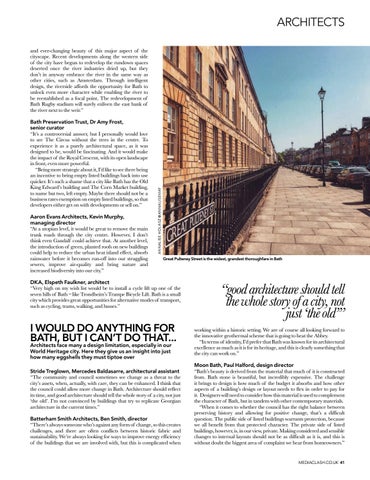ARCHITECTS
Bath Preservation Trust, Dr Amy Frost, senior curator “It’s a controversial answer, but I personally would love to see The Circus without the trees in the centre. To experience it as a purely architectural space, as it was designed to be, would be fascinating. And it would make the impact of the Royal Crescent, with its open landscape in front, even more powerful. “Being more strategic about it, I’d like to see there being an incentive to bring empty listed buildings back into use quicker. It’s such a shame that a city like Bath has the Old King Edward’s building and The Corn Market building, to name but two, left empty. Maybe there should not be a business rates exemption on empty listed buildings, so that developers either get on with developments or sell on.” Aaron Evans Architects, Kevin Murphy, managing director “At a utopian level, it would be great to remove the main trunk roads through the city centre. However, I don’t think even Gandalf could achieve that. At another level, the introduction of green, planted roofs on new buildings could help to reduce the urban heat island effect, absorb rainwater before it becomes run-off into our struggling sewers, improve air-quality and bring nature and increased biodiversity into our city.”
ANNALISE HOL ASZ @ANNALISEMAY
and ever-changing beauty of this major aspect of the cityscape. Recent developments along the western side of the city have begun to redevelop the rundown spaces deserted once the river industries dried up, but they don’t in anyway embrace the river in the same way as other cities, such as Amsterdam. Through intelligent design, the riverside affords the opportunity for Bath to unlock even more character while enabling the river to be reestablished as a focal point. The redevelopment of Bath Rugby stadium will surely enliven the east bank of the river next to the weir.”
Great Pulteney Street is the widest, grandest thoroughfare in Bath
DKA, Elspeth Faulkner, architect “Very high on my wish list would be to install a cycle lift up one of the seven hills of Bath – like Trondheim’s Trampe Bicycle Lift. Bath is a small city which provides great opportunities for alternative modes of transport, such as cycling, trams, walking, and busses.”
I WOULD DO ANYTHING FOR BATH, BUT I CAN’T DO THAT... Architects face many a design limitation, especially in our World Heritage city. Here they give us an insight into just how many eggshells they must tiptoe over
Stride Treglown, Mercedes Baldasarre, architectural assistant “The community and council sometimes see change as a threat to the city’s assets, when, actually, with care, they can be enhanced. I think that the council could allow more change in Bath. Architecture should reflect its time, and good architecture should tell the whole story of a city, not just ‘the old’. I’m not convinced by buildings that try to replicate Georgian architecture in the current times.” Batterham Smith Architects, Ben Smith, director “There’s always someone who’s against any form of change, so this creates challenges, and there are often conflicts between historic fabric and sustainability. We’re always looking for ways to improve energy efficiency of the buildings that we are involved with, but this is complicated when
“good architecture should tell the whole story of a city, not just ‘the old’” working within a historic setting. We are of course all looking forward to the innovative geothermal scheme that is going to heat the Abbey. “In terms of identity, I’d prefer that Bath was known for its architectural excellence as much as it is for its heritage, and this is clearly something that the city can work on.” Moon Bath, Paul Halford, design director “Bath’s beauty is derived from the material that much of it is constructed from. Bath stone is beautiful, but incredibly expensive. The challenge it brings to design is how much of the budget it absorbs and how other aspects of a building’s design or layout needs to flex in order to pay for it. Designers will need to consider how this material is used to complement the character of Bath, but in tandem with other contemporary materials. “When it comes to whether the council has the right balance between preserving history and allowing for positive change, that’s a difficult question. The public side of listed buildings warrants protection, because we all benefit from that protected character. The private side of listed buildings, however, is, in our view, private. Making considered and sensible changes to internal layouts should not be as difficult as it is, and this is without doubt the biggest area of complaint we hear from homeowners.”
MEDIACLASH.CO.UK 41
